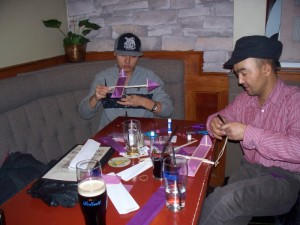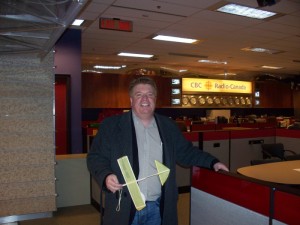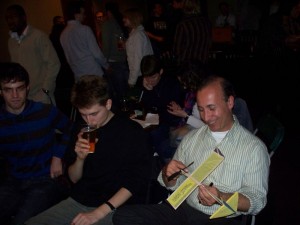 The Squirrel was covered in the Centertown News a paper in Ottawa. It got a full page in March 2010.
The Squirrel was covered in the Centertown News a paper in Ottawa. It got a full page in March 2010.
The reporter Chris Cooper attended one of the Squirrel-O-Rama model airplane socials.
A photographer had a separate meeting with me and took the picture at the right.
Here’s some of the text from the write-up in case their site is down:
Darcy Whyte rarely misses “Games Night” Wednesdays at the Atomic Rooster, but he doesn’t come to play darts – he would rather throw airplanes.
Early in the evening, Whyte can be easily spotted in his usual seating section, preparing to share his labour of love: the “Squirrel,” an inexpensive model airplane he designed himself.
“Sometimes, we make them and launch them down towards the dartboard,” Whyte explains with a grin. “In an environment like this, you don’t want to wind them up too much, because they can get pretty far.”
Whyte has hosted roughly 10 of these model airplane workshops for adults. The turnouts vary, but single workshops have managed to draw as many as 20 people.
Whyte can’t hide his own excitement as he explains the agenda. Each partipant gets a free building kit and then, after assembling their very own Squirrels – and downing a beer or two – they join Whyte in launching the model planes towards the back of the restaurant.
Whyte doesn’t charge admission for the workshop. Building the planes, he says, is an experience that should be accessible to everybody, regardless of how much money they can spare.
“It’s more fun than people think it is, and that’s the truth. I’ve seen the reactions in people’s faces,” says Sanjay Belkhode, a longtime friend who often assists Whyte in the workshops.
“Having a drink – you know, a ginger ale or a beer – makes it a little more fun, and it becomes very much a social exercise.”
Building model airplanes may be a new experience for the workshops’ first-time partipants, but not for Whyte, who says he has been doing it since he was a child.
Whyte only recently decided to move past the traditional models he had always been building in workshops and on his own. His new mission was to invent a safer, more accessible airplane.
“I injured myself once when I was doing a prefab [prefabricated model plane] for a workshop,” Whyte explains, recalling his time as a workshop leader at the Jack Purcell Community Centre. “And that made me think. It made me simplify the step – does it have to be so complicated?”
One simplification led to another and after dozens of different experimental prototypes, he had finalized the design for the Squirrel.
Whyte says he chose the name as a nod to the aviation community’s inevitable disapproval: “Squirrels are kind of, you know, sneaky . . . Never trust a squirrel.”
Whyte’s inexpensive, lightweight design features a flat wing – ensuring inexperienced builders’ Squirrels fly seamlessly, regardless of construction errors. Each frame is constructed with Ecuadorian balsa wood Whyte seeks out himself at American port cities where the wood is directly shipped from South America.
He also insisted that his planes feature parts that are safe for children to assemble. For example, while traditional elastic-powered model planes use metal hooks to anchor the elastic, Whyte substitutes a standard toothpick.
That emphasis on safety and simplicity – the only tools required for assembly are a pair of scissors and some glue – helped make the Squirrel extremely popular at local Boy Scout meetings, school demonstrations, and community centre classes.
“The model, without even my pushing it, had already propagated into these areas,” he says. “It’s becoming the model for schools, education, and general sharing of model aviation.”
Born and raised in Saskatchewan, Whyte came to Ottawa to study physics and ended up in computer science. Today, he juggles the Squirrel enterprise along with his work as a social media consultant for various locally-based companies.
Whyte says his background in social media, and particularly in search engine optimization, was the key to getting the Squirrel business off the ground when he started to retail the planes last summer.
Whyte also uses business and technology meet-ups events, such as DemoCamp and the Creative Thinkers group, as a venue to demonstrate his Squirrel planes.
Andy Church, who helps run a locally-based networking web site, happened to be at one of those events several weeks ago, where one of Darcy’s planes sailed over the audience and hit him on the head.
“I ordered three of them when I got home that day, off the web,” Church recalls. “I answered the doorbell a little while later and it was him standing there.”
Church says as a father, he appreciates the planes’ ease of use and simple design, but the most compelling part of the business is Whyte’s relentless interpersonal approach.
“What was interesting in his model was using social outings,” Church explains. “He’s really created an experience that’s not just the plane . . . It’s more in keeping with who he is.”
While the free plane-building events have made the squirrel a well-established presence in downtown Ottawa, Whyte says the product has seen incredible success outside of the local market.
“The mail order business is healthy,” he says. “This is made here in Ottawa; designed here in Ottawa. And it’s sold all over the world now.”
He says the Squirrel planes, which retail internationally from his web site, have sold well in New Zealand, Australia, Ireland, and the U.S. The design has also been featured in various publications around the world including the Model Airplane News, Scouts Canada’s official magazine, and a Brazilian magazine that put the Squirrel on its cover last year.
“You can go to a newsstand in any city in the world and you’ll find it,” Whyte says.
But even with all the recent global attention, Whyte is now turning his focus back towards downtown Ottawa. He is currently pitching his model plane demonstration to the Boys and Girls Club, the Ottawa Mission, and a handful of similar charities and services around the city.
“I’m basically putting an offer out to all these charities that I can get my hands on,” he says. “I’m organizing a group of volunteers, and we’re going to go into Alzheimer’s wards and things like that, and get them running around. You know, as long as we don’t have any broken hips it’ll be okay.”
And while he waits to hear back from those charities, he is keeping busy with yet another philanthropic project: developing educational pages for children, which he hopes will help them learn mathematical and other concepts using his planes.
Because at the end of the day, he explains, even the adult-oriented events like his community workshop are ultimately about passing on the joy of aviation to future generations.
“This will obviously increase the chance that people will take these things, and eventually take the concepts and share them with children,” he says. “If you don’t teach the adult, then the kid’s never going to get it.”























































































